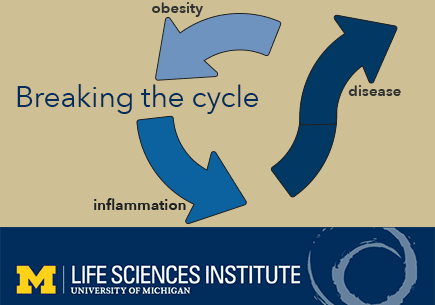Breaking the cycle of obesity, inflammation and disease

Researchers at University of Michigan have illuminated an aspect of how the metabolic system breaks down in obesity. The findings provide additional evidence that a drug entering clinical trials at the university could reverse obesity, Type 2 diabetes and fatty liver disease in humans.
In a paper scheduled for online publication in the journal eLife on Dec. 24, Alan Saltiel, the Mary Sue Coleman Director of the Life Sciences Institute, explains how, in obesity, fat cells stop responding to hormones known as catecholamines that trigger them to expend more energy. However, the fat cells of obese mice treated with a drug called amlexanox regained sensitivity to catecholamines, burned the excess energy and returned to normal size.
Next month, scientists at U-M will begin a placebo-controlled clinical trial of amlexanox to test its efficacy as a drug for treating obesity and diabetes in humans. Formulations of amlexanox are prescribed in different international markets to treat asthma and canker sores.
Obesity leads to a state of chronic, low-grade inflammation in liver and fat tissue. Scientists believe that inflammation links obesity and insulin resistance via a pathway called NFkB, which is involved in the regulation of a range of cellular processes and activated in obesity.
Activation of NFkB increases the levels of a pair of genes, IKKε and TBK1, which in turn reduce the ability of certain receptors in the fat cells of obese mice to respond to catecholamines like adrenaline, "fat-burning" hormones generated by the sympathetic nervous system in response to stress.
"We've suspected that in obesity, fat cells become less sensitive to catecholamines such as adrenaline, and that this reduced sensitivity in turn reduces energy expenditure, but the details of this haven't been fully understood," Saltiel said.
High levels of IKKε and TBK1 also resulted in lower levels of a second messenger molecule called cAMP, which increases energy expenditure by elevating fat burning.
Amlexanox interfered with the two enzymes and restored sensitivity to catecholamine, allowing the fat cells to burn energy.
In research published in February 2013, Saltiel found that amlexanox reversed obesity, diabetes and fatty liver in mice. The forthcoming eLife paper explains in part how amlexanox works.
"There is considerable evidence to suggest that in states of obesity, adipose tissue becomes less sensitive to catecholamines because IKKε and TBK1 act as a sort of brake on metabolism, and that this reduced sensitivity in turn reduces energy expenditure," Saltiel said. "By releasing the brake, amlexanox seems to free the metabolic system of mice to burn more and possibly store less energy in response to catecholamines."


















